What is hip nailing surgery?
Hip nailing surgery is an operation that includes reconnecting the broken bone fragments of the femur near the hip joint using screws, pins, or plates. It’s an option to treat a hip fracture, which is a common injury among older adults. Hip nailing surgery in Iran gives patients the chance to experience an ideal surgery.
The hip nailing surgery aims to decrease pain, enhance mobility, and prevent complications from hip fractures, such as nerve damage, infection, or blood clots. The procedure may also help prevent osteonecrosis (bone death) or nonunion (failure of the bone to heal) that may occur with some types of hip fractures.
Some other names for the hip nailing surgical procedure include hip screwing, fracture repair, and internal fixation. The operation is called hip nailing or pinning because of the use of pins and/or nails to fix the bones in the correct position.
Cost of Hip Nailing Surgery in Iran
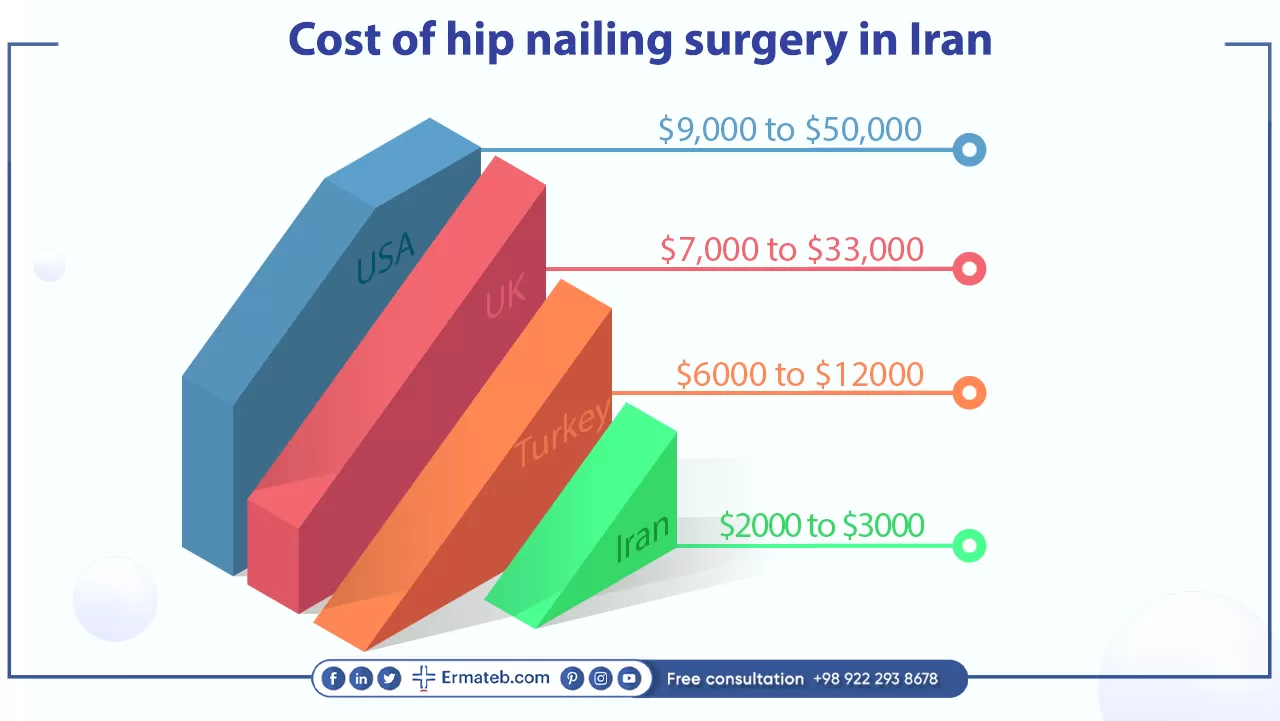
Patients often look for a treatment that is high quality and performs at a reasonable price. In some countries, patients may not be able to undergo hip nailing surgery due to high prices. But there is another option for them. They can have their treatment overseas, pay less for this surgery than in their own country, and enjoy the best quality of their operation. Having your hip nailing surgery in Iran gives you this opportunity to get your procedure at a low cost.
The cost of hip nailing surgery in Iran is different from one hospital or medical center to another. In addition, the cost of a hip nailing operation depends on factors such as hip screw price and the surgeon's experience. Generally, patients can have a hip nailing surgery in Iran at costs between $2,000 to $3,000.
Iran offers its medical treatments at affordable prices. In general, the same procedure can be quite expensive in other countries. For instance, in the United States and the United Kingdom, the price ranges from $7,000 to $33,000.
The low prices here are not because of the low quality of the services. The high number of patients who come to Iran to get their treatments, and the low currency of this country against other countries are the two main reasons for the affordable prices in Iran. Therefore, international patients can get their hip nailing surgery in Iran at a good quality. To get more information about having this surgery in Iran and the exact cost, contact Ermateb now.
Who can be a candidate for hip nailing surgery in iran?
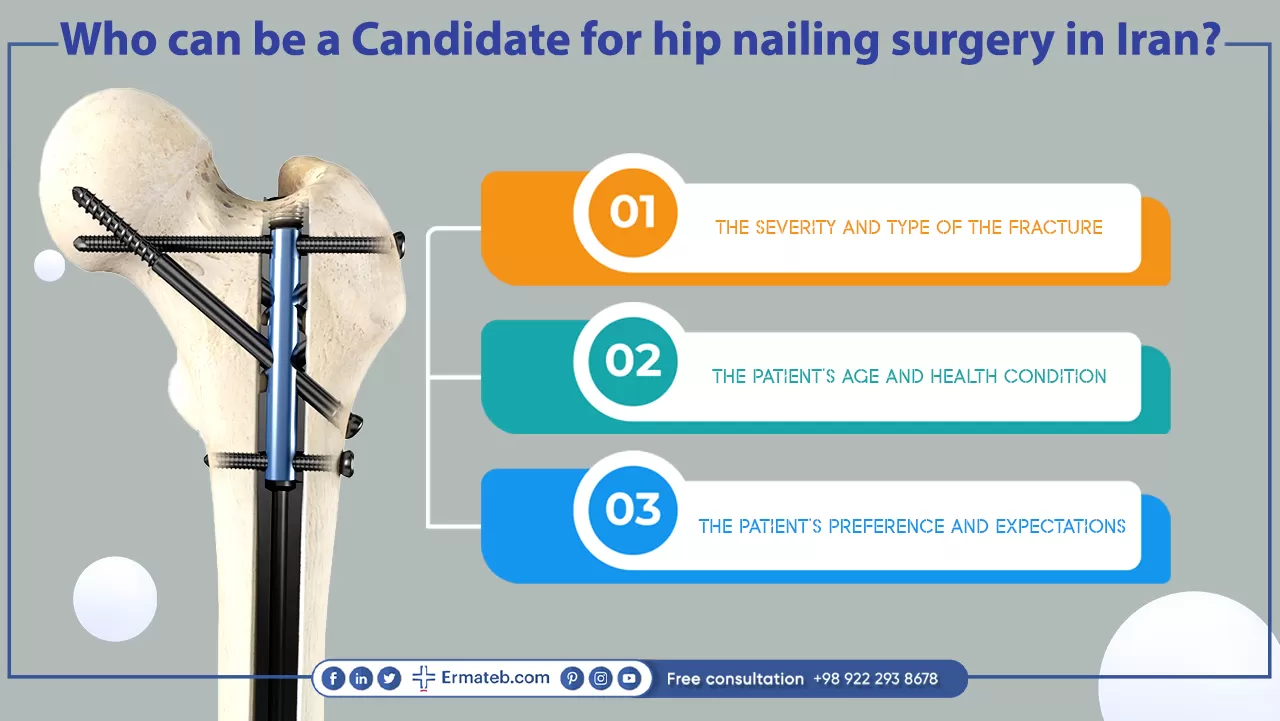
You can be a good candidate for hip nailing surgery if you have a hip break that involves the upper part of the femur. Depending on the nature of the break, the person might need to have a hip replacement. It can prevent further injury that can lead to problems such as arthritis. However, not all people with hip fractures are suitable for a hip nailing operation. Some factors that can affect the eligibility of a person for this surgery are:
1.The severity and type of the fracture: Some fractures may be too displaced or unstable to be fixed by hip nailing. For instance, fractures that involve the neck and head of the femur (intracapsular fractures) may need a partial hip replacement instead.
2.The patient’s age and health condition: The hip nailing surgical procedure needs operation, which has some risks like bleeding, infection, nerve damage, blood clots, and anesthesia side effects. Therefore, the patient’s overall health condition and medical history should be evaluated before undergoing this surgery. Some conditions that may raise the risk of side effects or poor results are diabetes, osteoporosis, kidney disease, heart disease, and smoking.
3.The patient’s preference and expectations: A hip nailing surgical procedure may not provide adequate fixation for some people, especially for people with poor bone quality or osteoporosis. This can lead to loosening of the screws, failure of the implant, or nonunion of the fracture (failure of the bone to heal). In some cases, a revision operation may be needed in the future if the implant fails or causes problems like infection, pain, or mental allergy. Therefore, the patient should be informed about the advantages and risks of this operation and have realistic expectations about the recovery and result.
Types of hip nailing surgery
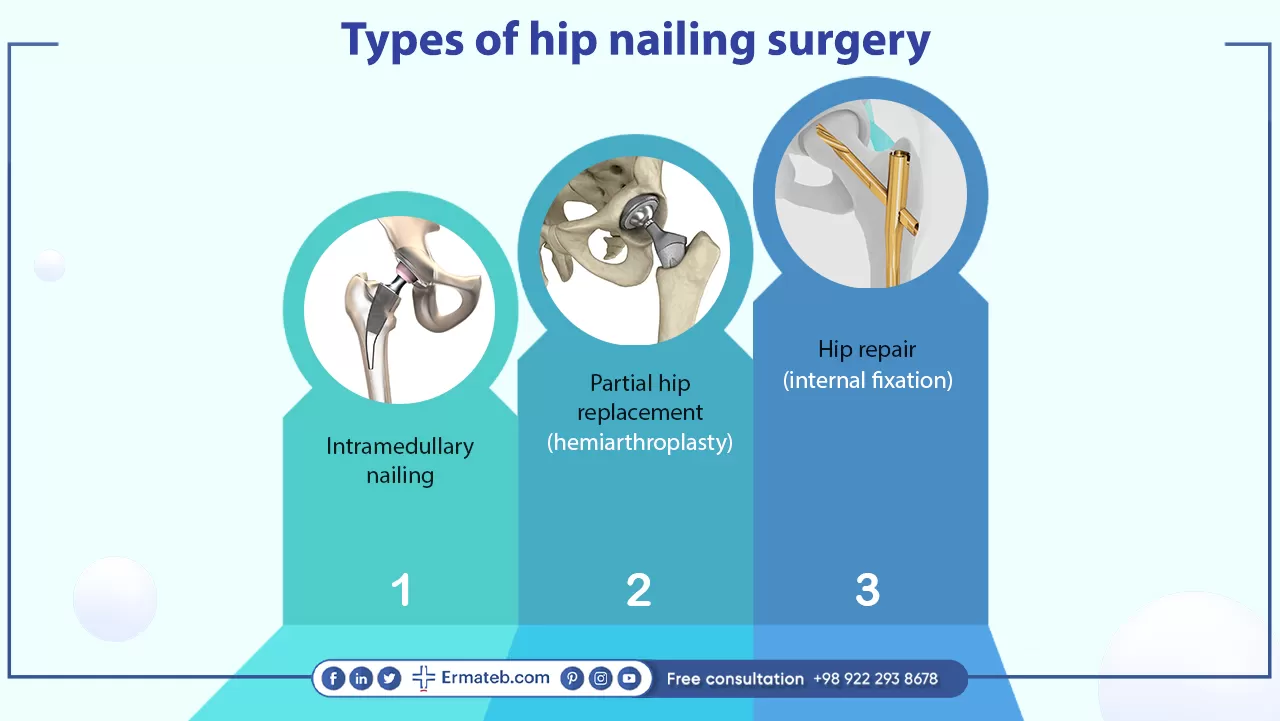
Generally, there are 3 types of hip nailing that are used to treat the broken hip:
1.Hip repair (internal fixation): This technique is used to treat broken bones that can be aligned together properly. the surgeon inserts surgical nails, screws, or even plates into the patient’s bone. Sometimes they will attach the screws to a metal plate placed along the thigh bone.
2.Partial hip replacement (hemiarthroplasty): Usually, this is done if the ends of the fractured bone are injured or out of place. The surgeon eliminates the head and neck of the femur and replaces them with an artificial ball that fits into the hip socket.
3.Intramedullary nailing: A permanent rod or nail is placed into the center of the bone. This will help the patient be able to put weight on the bone.
Each type of hip nailing surgery has its own pros and cons, and the surgeon will recommend the best option for the patient based on the situation.
Before the surgery
Before the hip nailing operation, there are some things patients need to do to prepare themselves and decrease the risk of complications. some of the steps include:
1.Don’t eat or drink after midnight on the day of the surgery. This will prevent nausea and vomiting during or following the operation.
2.The surgeon will tell you which medicines you should take or not take on the day of the procedure. Some medicines may raise the bleeding or interfere with anesthesia.
3.You’ll be given an antibiotic through the IV to help prevent a bacterial infection. Infection is a serious complication of hip nailing operation.
4.You may need to have certain tests before the operation, like chest X-rays, blood tests, urine tests, or electrocardiograms. The tests will help the surgeon assess your health condition and plan the operation.
5.You may need to donate your own blood before the procedure, in case you need a transfusion during or following the operation. It’s called autologous blood donation and it decreases the risk of getting an infection.
6.Stop smoking at least 2 weeks before your operation, as smoking can delay the healing process and raise the risk of infection and blood clots.
7.Arrange for someone to drive you home after your procedure since you won’t be able to drive for some time. You may also need someone to stay with you and help with your daily activities, like bathing, dressing, cooking, and cleaning.
8.You may need to prepare your home for the recovery period, such as making sure you have a chair with arms, a comfortable bed, a shower chair, a raised toilet seat, and a walker or crutches. You may also need to eliminate any cords, rugs, or clutter that cause you to trip or fall.
How is hip nailing surgery performed?
During the hip nailing surgery, the surgeon will make one or two incisions on the side of the patient’s leg. After the surgeon puts back the bone into the right position, he’ll fix it in its place using nails, pins, screws, rods, or metal plates.
After the pinning or nailing is complete, the surgeon will perform an X-ray image to ensure the bone is in its place. Afterward, the surgeon will use stitches or staple the wound to close it. This operation usually takes between 2 to 4 hours. It’s usually done under general anesthesia, but in some cases, the surgery will be performed under local anesthesia.
There are many types of screws that the surgeon may use in the surgery. In some cases, the surgeon uses a hip dynamic screw that is designed to let the bone slide dynamically in a certain way. In other conditions and cases, the surgeon will use individual screws for the fixation of the bone.
Advantages and disadvantages of hip nailing surgery in Iran
Advantages:
1.This procedure can improve mobility, pain, and range of motion of the hip joint.
2.This surgery can prevent complications like avascular necrosis, which is the death of bone tissue because of lack of blood supply, and arthritis which may occur if the fracture isn’t treated properly.
3.The hip nailing surgery can allow the patient to bear weight on their leg sooner than other methods, like compression hip screws or plates.
4.The procedure can preserve the patient’s natural hip anatomy and function, unlike a hip replacement that eliminates the damaged parts of the hip and replaces them with artificial implants.
Disadvantages:
1.The surgery carries some risks and complications such as bleeding, blood clots, infection, nerve damage, and anesthesia complications.
2.It may not be a good option for some types of fractures, like those that are very unstable or displaced.
3.It may not provide adequate fixation for some people, especially people with osteoporosis or poor bone quality. It may cause loosening of the screws, failure of the implant, or nonunion of the fracture (failure of the bone to heal).
4.It may need revision operation in the future if the implant fails or causes problems like infection, pain, or metal allergy.
The risks and side effects of hip nailing surgery
Patients who have hip nailing may experience some short-term complications and long-term complications. The risks and complications of hip nailing surgery are:
1.Bleeding
2.Blood clots: Clots can form in the leg veins following the surgery, which can be dangerous if they travel to the patient’s lungs or heart.
3.Arthritis
4.Different leg lengths: The patient’s legs may not be of equal length after the operation, which can affect the gait and balance.
5.Breathing problems following the surgery. These are more common if the patient has had general anesthesia and a breathing tube.
6.Heart attack or stroke during or following the surgery.
7.Infection in the joint, urinary tract, or lungs.
8.Poor wound healing.
9.Fracture: During the surgery, healthy parts of the hip joint might fracture. The implant may fail or loosen over time, needing a revision procedure.
10.Dislocation: The artificial hip may come out of its socket, especially in the first months following the operation.
11.Nerve damage in the leg: Nerves near the hip joint may be damaged during the operation, causing weakness, numbness, or pain in the patient’s leg.
These risks and side effects aren’t very common and can be prevented or treated with medications and proper care. The patient should discuss with the doctor the benefits and risks of the hip nailing procedure for their specific case. Patients should also follow the doctor’s instructions following the surgery to ensure a smooth recovery and prevent side effects.
The recovery process of hip nailing surgery
The recovery process of a hip nailing operation depends on many factors, like the severity and type of the fracture, the patient’s health condition and age, the quality of the operation and implant, and compliance with postoperative care and rehabilitation. The recovery period may vary from 4 weeks to 6 months.
you will stay in the hospital for about 1-2 days after the procedure, where you’ll receive antibiotics, pain medication, and blood thinners to prevent complications. After that, you will be transferred to an extended-care facility or a rehabilitation hospital, where you will receive occupational therapy and physical therapy to help you regain the mobility, strength, and function of your hip.
You’ll be advised to follow precautions to protect your hip, like avoiding bending your hip more than 90 degrees, crossing your legs, or twisting your hip. You’ll be allowed to bear weight on your leg as tolerated, with the help of a crutches or walker.
You will need to follow up with the surgeon regularly to monitor the wound healing and bone healing process. You will also need to take care of the wound and prevent infection by keeping it dry and clean. You will be able to resume light activities or office-based work within about 6 weeks. However, you should refrain from extreme movements or sports where there is a risk of falling, such as riding or skiing.
You will continue to improve your hip range of motion and function with stretches and exercises. You may also need aquatic therapy or massage therapy to ease the stiffness and pain. You’ll need to maintain a healthy lifestyle by taking calcium and vitamin D supplements, eating a balanced diet, avoiding alcohol, and quitting smoking. These help prevent osteoporosis and improve bone health.
The recovery from a hip nailing operation can be lengthy and challenging, but with guidance and proper care, you can achieve a good result and resume normal activities. Following the procedure, the doctor will give you some painkillers and some medicine to prevent blood clots. You better have a urinary catheter in order to urinate without leaving your bed.
Can I walk after a hip nail operation?
It depends on the complexity and type of the hip nail surgery, the patient’s condition, and their recovery progress. However, the patient may be able to walk following a hip nail surgery, with some guidance and precautions.
The patient will be encouraged to get up and walk as soon as possible following the procedure, with the help of a walker or crutches, and they will be able to walk on the same day or the next day after the operation.
Can I drive after a hip nail operation?
This may depend on many factors, like the type of operation, the level of pain, the type of anesthesia, and the range of motion. In general, patients shouldn’t drive a car if they’re still taking narcotic pain medication, or have a hard brace or cast that limits their mobility. Patients should also consult the doctor before driving. They can usually drive a car after almost 6 weeks, subject to advice from the surgeon. Therefore, it’s important to follow the doctor’s instructions and recommendations regarding driving following a hip nail surgery.
Hip nailing vs. replacement
Hip nailing is a procedure that is done to hold the bone in its place using pins or screws. This procedure is used when the bone or the joint is not damaged. Hip replacement surgery is done when either or both of them are damaged. The surgeon might need to replace the joint and the bone with metal parts, depending on the case.
Hip screw removal operation
When patients have plates or screws put into their bodies, they’ll wonder if they would stay in there forever. generally, they will stay forever with no need to eliminate them. In some cases, if the screws loosen for any reason and cause pain, then they will need a hip screw removal operation.
Usually, hip screw removal is an easy operation. Your surgeon will make a little incision in the location of the screw and twist the screw until it comes out.
ORIF vs. hip nailing
ORIF, which stands for Open reduction and internal fixation, is an operation that is performed to treat thigh fracture that includes breaking the bone into 2 pieces or more. This is while a hip nailing operation is done when the fracture doesn’t need repositioning of the broken bone.
Pregnancy and hip nailing
When a pregnant woman needs a hip nailing operation, she should ask her gynecologist if it’s OK to undergo this surgery depending on her condition. Hip pinning operation requires approval from an orthopedic, a gynecologist, and an anesthesiologist.
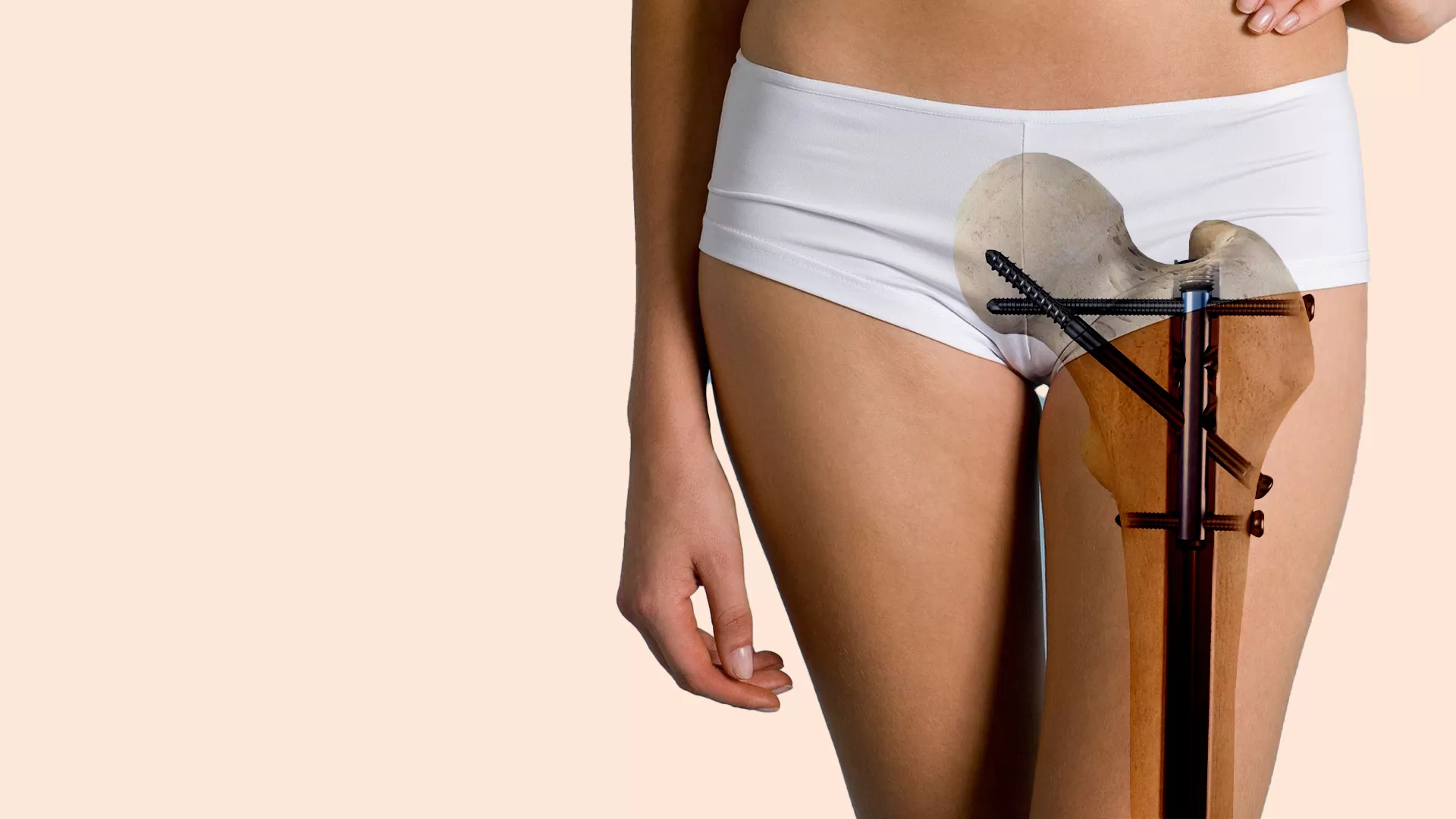

 Arabic
Arabic
 German
German
 Persian (Farsi)
Persian (Farsi)
 Russian
Russian
 Beauty
Beauty



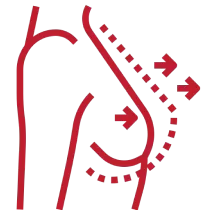


 Medical
Medical




 Hotels
Hotels
 Hospitals
Hospitals































![Frequently asked question about [name]](/v2tem/images/pages/service/faq-image.webp)
